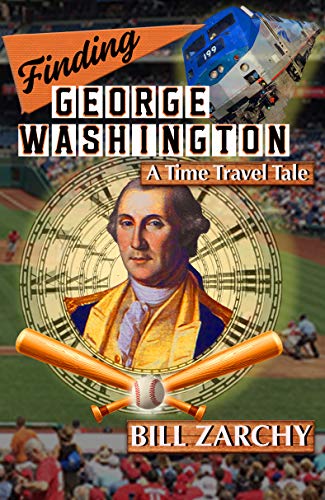Finding George Washington: A Time Travel Tale received a 4+ star review, making it an IndieReader Approved title.
Following find an interview with author Bill Zarchy.
What is the name of the book and when was it published?
Finding George Washington: A Time Travel Tale. Published 11/20/20
What’s the book’s first line?
Valley Forge, February 22, 1778 — A new freeze gripped the valley, and a few inches of virgin white covered the now-frozen ruts in the roads. When the soldiers first arrived at this winter encampment two months before, rain and cold had compounded the misery of the men. Lately it had been freezing and snowing, making the hardened ground easier to traverse than the sleety, slippery mud had been.
What’s the book about? Give us the “pitch”.
On a freezing night in 1778, General George Washington vanishes. Walking away from the Valley Forge encampment, he takes a fall and is knocked unconscious, only to reappear at a dog park on San Francisco Bay—in the summer of 2014.
Washington befriends two Berkeley twenty-somethings who help him cope with the astonishing—and often comical—surprises of the twenty-first century.
Washington’s absence from Valley Forge, however, is not without serious consequences. As the world rapidly devolves around them—and their beloved Giants fight to salvage a disappointing season—George, Tim, and Matt are catapulted on a race across America to find a way to get George back to 1778.
Equal parts time travel tale, thriller, and baseball saga, Finding George Washington is a gripping, humorous, and entertaining look at what happens when past and present collide in the 9th inning, with the bases loaded and no one warming up in the bullpen.
What inspired you to write the book? A particular person? An event?
As a kid, I loved baseball and cherished my collection of player cards. I had hundreds of them, including, I’m pretty sure, a rare Mickey Mantle rookie card, now worth millions. When I was about eight or nine, my dad gave me an old set of U.S. President cards, with photos and vital stats on the front and detailed info on the back.
The cards were smaller than the typical 2.5” x 3.5” baseball cards I loved. But I was fascinated by the presidents. The set had been published a couple of decades earlier. It covered all the presidents from GW to FDR. It stated that Roosevelt’s Term of Office was “1933 – “ so the cards were published some time during his twelve-year tenure. For some reason, the Millard Fillmore card was missing from the set. Nevertheless, I became that annoying kid who could and would recite the list of presidents in order, at the drop of a hat.
I was entranced by Washington in particular, both the city and the man. As a teenager, I enjoyed staying with family in D.C. and touring the White House, the Capitol, the FBI, and the monuments on my own. As a junior in high school, I read and loved The American Presidency, by Cornell Professor Clinton Rossiter. I mailed him a copy of a school paper I wrote, based partially on his book and received a gracious note in return.
I went on to major in Government at Dartmouth, and, decades later, shot interviews with Presidents Clinton, Ford, and Carter for aWest Wing documentary about what it’s like to work in the White House. (All in all, I’ve met six presidents and shot five of them … but that’s another story.)
George had long since become my touchstone for trying to understand the alluring technology of my mid-century boyhood: aviation, photography, trains, cars, rockets, satellites, television, movies. How would I explain this to George Washington, if he were to come back to life right here, right now?
A few years ago, I decided to bring George back, albeit in unfamiliar surroundings. This book is the result. Enjoy.
What’s the main reason someone should really read this book?
It’s a fun read that incorporates elements of low-tech sci-fi, a gripping thriller, time travel, baseball, and historical characters and situations from the American Revolution. Exciting and suspenseful, fast-paced, poignant and hilarious. And it takes on big themes like Washington’s slave ownership. In an effort to present an accurate and respectful portrait of Washington, I consulted many books, rode Amtrak from California to Philadelphia, visited Valley Forge, Independence Hall, the Liberty Bell, Mount Vernon, Colonial Williamsburg, the Smithsonian National Museum of American History, the Washington Monument, New York City, Mendocino, the Doe Library at UC Berkeley, Citizens Bank Park in Philadelphia, and AT&T Park in San Francisco.
What’s the most distinctive thing about the main character? Who-real or fictional-would you say the character reminds you of?
I originally thought of Finding George Washington as a comical, fish-out-of-water story, but as I learned more about my subject, so much emerged about George. A charismatic leader, but a soft-spoken, uninspiring orator. A courageous man, who endured the burden of dental pain throughout his life. A powerful, ambitious man, but a kind, gentle husband and stepfather. A 6’2” giant, at a time when most men were much shorter. A skillful horseman, a graceful dancer, a man’s man who enjoyed the company of women.
Perhaps most significantly, like most of the Founding Fathers, he was a slave owner. History establishes that Washington, privately, had at least a dawning awareness that slavery was evil and immoral. But both George and Martha felt betrayed when two enslaved people—her maid Ona Judge and the family cook Hercules—ran away from their Philadelphia household during his presidency. Exhibiting unfathomable arrogance, both Washington’s resented their “disloyalty.”
At the time of George’s death in the waning days of the eighteenth century, the Washington’s had retired to Mount Vernon, home to more than 300 enslaved people. He attempted to free them en masse, to make a powerful statement. In his will, George declared that all slaves he owned would be freed after his beloved Martha died. He provided for the education and training of slave children, as well as homes for their sick and elderly.
But … it’s complicated. George only owned 123 of the slaves himself. Under Virginia law, he had no control over those slaves who had come from the estate of her late first husband, Daniel Parke Custis, four decades earlier. Plus the two groups of enslaved humans had long since intermarried.
Distraught over George’s passing, Martha never again slept in the master bedchamber they had shared at Mount Vernon, staying instead in a garret room on the third floor. She outlived him by a couple of years. During that time, as the slaves George had owned anticipated their impending freedom, she feared they might hasten her passing in order to achieve it. So she freed them herself, signing a Deed of Manumission at the end of 1800.
After Martha’s death in 1802, the 153 dower slaves, descendants of the enslaved people from the Custis estate, met a tragic—but typical —fate. Within a short time, her grandchildren had sold or split up most of these slaves, breaking up families, separating children from parents, and continuing their bondage indefinitely into future generations.
When did you first decide to become an author?
I have always been a writer. My dad gave me an old typewriter when I was very young, and I soon was charging family members a quarter each to subscribe to my new family news service. It helped that I grew up in the house of a writer. My dad, Harry Zarchy, wrote over 30 books on crafts and hobbies and the outdoors, mostly published by Alfred A. Knopf. I was on the newspaper staff in high school and rose to become Managing Editor of The Dartmouth, America’s Oldest College Newspaper. Putting out a daily paper was an amazing challenge. After film school at Stanford, I had a long career in cinematography, for decades concentrating on visual storytelling. I started writing again a little over 20 years ago, chronicling my work and travels filming all over the world. I joined a writers group and in a few years began to write fiction. This debut novel, Finding George Washington: A Time Travel Tale, has been in process for seven years.
Is this the first book you’ve written?
This is my first novel, but my second book. I published my first book in 2013: Showdown at Shinagawa: Tales of Filming from Bombay to Brazil. It’s nonfiction, a collection of true stories of my work as a cinematographer on six continents, about traveling far away to work with people in another culture. It’s funny and poignant, always looking for commonality with my colleagues and foreign film crews. My career included filming three former presidents for the Emmy-winning West Wing Documentary Special, the Grammy-winning Please Hammer Don’t Hurt ‘Em, feature films Conceiving Ada and Read You Like A Book, PBS science series Closer to Truth, musical performances as diverse as the Grateful Dead, Weird Al Yankovic, and Wagner’s Ring Cycle, and countless high-end projects for technology and medical companies.
What do you do for work when you’re not writing?
I worked freelance as a director of photography (cinematographer) for over forty years, shooting film projects all over the U.S. and in thirty other countries as well. My career included filming three former presidents for the Emmy-winning West Wing Documentary Special, the Grammy-winning Please Hammer Don’t Hurt ‘Em, feature films Conceiving Ada and Read You Like A Book, PBS science series Closer to Truth, musical performances as diverse as the Grateful Dead, Weird Al Yankovic, and Wagner’s Ring Cycle, and countless high-end projects for technology and medical companies. I also taught Advanced Cinematography at San Francisco State for twelve years and various lighting classes and workshops at several other colleges. I retired in 2015.


